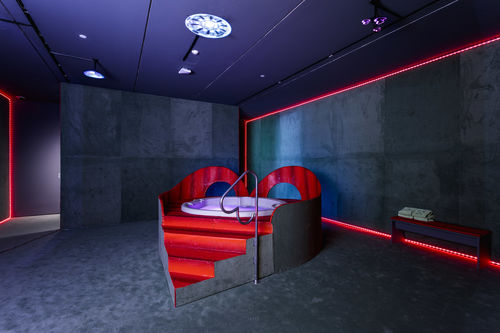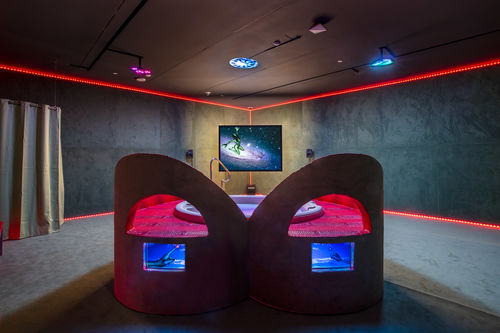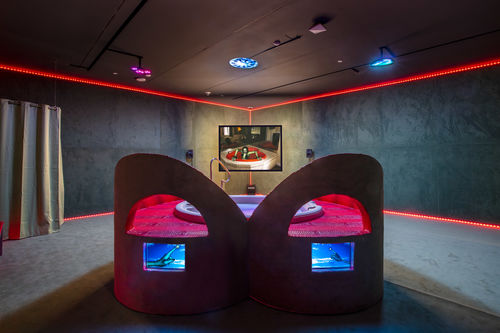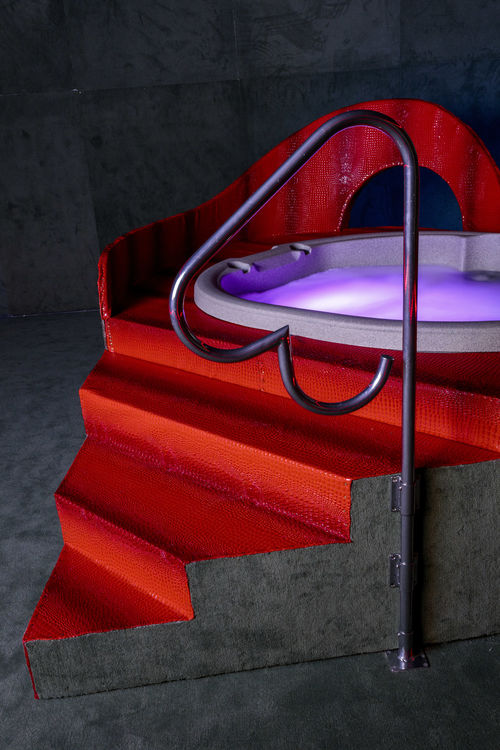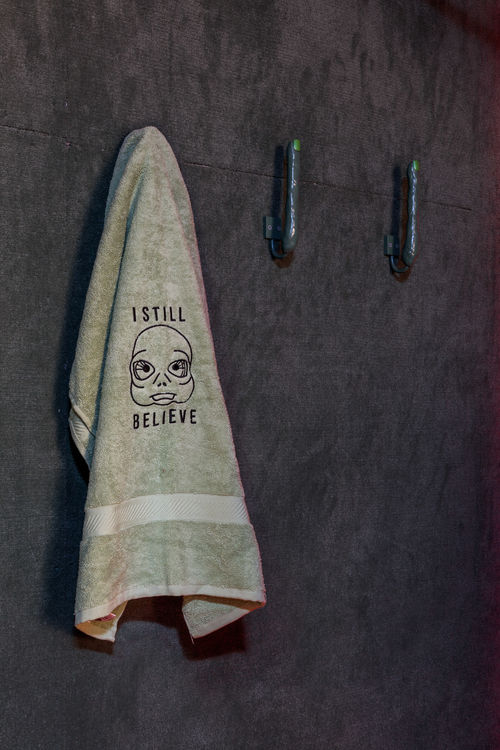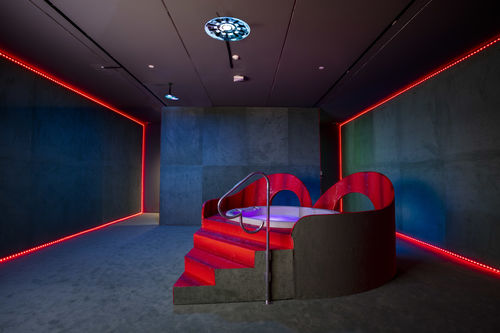
Hammer Projects: Tita Cicognani
- – This is a past exhibition
A museum gallery is typically designed to be a sterile environment for the public display of works of art. The functioning hot tub at the center of this installation by the Los Angeles–based artist Tita Cicognani disrupts and transforms the museum’s supposed sterility, inviting visitors to immerse themselves in a space that promotes intimacy and speculates about alien contact. Audiences may schedule a time to soak in Cicognani’s Heart Tub (2022) alone or in groups of two to four throughout the duration of the exhibition in addition to taking part in the work’s surroundings as a witness. By creating a space for physical contact and intimacy within an institutional setting, Cicognani’s Heart Tub asks viewers to examine their relationship to germs and the precariousness of the body at a moment of heightened concern.
Cicognani’s installation conjures the setting of an alien love hotel, with carpet adorning the floor and walls and digital holograms perched overhead. The hot tub offers the ideal vantage point for viewing Cicognani’s I Still Believe (2022), a video composed primarily of still images with overlaid digital animations that depict a sequence of encounters involving alien contact and a hot tub not unlike the one at the center of the installation. The video features animated GIFs of a nude, black-haired, green-skinned, computer-generated character—an avatar in the likeness of Cicognani that has been a mainstay of much of the artist’s work to date. An accompanying soundtrack of slowed-down pop songs contributes to the immersive environment, which serves more broadly as a portal suggesting the possible existence of other worlds and facilitating escapist fantasies.
Hammer Projects: Tita Cicognani is organized by Aram Moshayedi, Robert Soros Senior Curator, with Nicholas Barlow, curatorial assistant.
Biography
Tita Cicognani (b. 1993, New York City) lives and works in Los Angeles. She received her BFA from Otis College of Art and Design in 2017 and her MFA from ArtCenter College of Design in 2021. Her work has been included in such group exhibitions as Your Gaze Makes Me at Kylin Gallery, Los Angeles (2021); …And Elsewhere at Charles Long Projects, Pomona, CA (2021); and Smashing into My Heart at the Renaissance Society, Chicago (2022). A solo exhibition of Cicognani’s work, titled Infinite Caca, was presented at Leroy’s in Los Angeles (2022). The presentation at the Hammer marks the artist’s first solo exhibition in a museum.
Essay
By Juliana Halpert
“Is part of the new national Us a surfeit of affluent vulgarity?” Thus spoke Life magazine in a special double issue published on January 8, 1971, dedicated to what it deemed the “New Shape of America.” “How about a honeymoon lodge, for instance?” The large text tumbles down the left edge of a left-hand page, next to a photograph that fills the rest of the spread. “Apparently, just being with each other doesn’t seem to be enough.” It’s a sensational image, and back then it made a big splash.“We need, or think we need, some affirmation—mirrors, heart-shaped pools—to tell us we’re really here at last.”1
Here at last. What had America and its supposed new shape arrived at, exactly? The photograph showed a young white couple sucking face in one of the country’s very first heart-shaped bathtubs, invented and installed at the Cove Haven Resort in the Poconos by a spectacle-minded new owner. A reflection in one of the many mirrors installed around the tub reveals the camera, perched on a tripod atop the scarlet-hued carpet, staring straight back. The woman bather gently clutches the shutter-release cord against the tub’s tiled edge; she is both photographer and photographed, capturing herself and her hubby from the disembodied eye of another. This primeval selfie and its magazine write-up consummated the country’s love of, well, love—specifically, the honeymooning, heterosexual, post–Summer of Love type of love, the kind that allegedly climaxes just after matrimony and blossoms in a bubble bath. It was pure kitsch, of course, but romantic getaways to Pennsylvania’s newly dubbed “Land of Love” became all the rage among America’s middle class. Heart-shaped bathtubs and hot tubs soon proliferated countrywide, with the gradual yet inevitable trickle-down to the tiled floors of roadside inns and the corners of hourly rate motel rooms. Life imitates Life.
Fifty years later, a heart-shaped tub has made its way into a museum. As the centerpiece of Tita Cicognani’s installation at the Hammer Museum, it’s less a cultural artifact than a living, bubbling, steaming thing, beckoning visitors to don their bathing suits and very literally get in. Resting atop a drab green carpet that covers the gallery floor and walls, it certainly delivers a surfeit of affluent vulgarity, if we instead use affluent’s original meaning—flowing freely. (This is no five-star honeymoon suite.) Heart Tub (2022) lends an excess of freedom rarely, if ever, encountered in a museum, especially in today’s hyper-sanitary atmosphere. A sea of texture, the tub and its surrounding space not only permit touching—the work, the water, each other—but practically mandate it, taking the concept of immersion as literally as possible.
This is Cicognani’s third hot tub and the first to be installed in an institution. In 2021, during her final term in the master of fine arts program at ArtCenter College of Design in Pasadena, she created The Mothership, a gargantuan octagonal enclosure lined with mirrors, its towering outer walls covered in pink and green faux crocodile leather. Multicolored disco balls turned its interior into a kaleidoscopic, clubby phantasmagoria. Installed in an empty room in the MFA program’s makeshift studios in Chinatown—school facilities were shut down—the tub had an inflatable basin and was fully operational. Students and visitors were welcome to use it, and they frequently did. In early 2022, Grotto Tub became the second incarnation, installed at the artist-run space Leroy’s, which occupies the former Thanh Vi Restaurant, also in Chinatown. At the center of the space’s linoleum-tiled, wood-paneled main room, Cicognani’s sophomore soak was covered in fake stone and appliqués of doves, butterflies, and bougainvillea blossoms. Several small PVC-pipe fountains on its exterior circulated a dark brown effluent, equal parts decadent and disgusting. The opening and closing receptions for the exhibition went on until 1 a.m., befitting the tub’s kitschy conjuring of Playboy Mansion–cum–ancient Roman bacchanalia.
Both The Mothership and Grotto Tub were portals into other worlds, squatting in spaces that are squatting themselves, retrofitted with a somewhat renegade spirit. The tubs’ hyperbolized, campy decor underscored the stark contrast between their lurid inner realms and barren surroundings, evoking Robert Venturi’s treatise on postmodern pleasure-zone architecture in Learning from Las Vegas: “Essential to its imagery,” he explains, is “the quality of being an oasis in a perhaps hostile context, heightened symbolism, and the ability to engulf the visitor in a new role.”2 Engulf they certainly did, but their respective contexts—though hardly plush—weren’t as hostile to hot tubs, and to the social roles that they produce, as is an institution dedicated to the presentation and preservation of art. The latter, though typically devised and designed for its own specific purpose, is much more bound to certain credos and to its relationship with the public. To disrobe in a museum during daytime hours is altogether different.
In recent history, several institutional exhibitions have addressed the act of undressing, inviting visitors to counter the common standards of museum conduct. In 2000 the artist Pia Lindman installed Public Sauna in the courtyard of MoMA PS1 in Long Island City, modeled after the saunas she grew up frequenting in her home country of Finland, where, in her words, “all socially constructed positions are left behind with the clothing in the locker room.”3 To align with American customs, the sauna was separated into two segregated chambers, each able to accommodate a single person at a time. Museumgoers were welcome to enter fully nude, though most opted for a swimsuit or towel. Lindman stood by as participants exited, bearing a bucket of cold water, keen to observe their attitudes about their own naked bodies. Ten years later, Suprasensorial: Experiments in Light, Color and Space, an exhibition at the Museum of Contemporary Art, Los Angeles, featured a large neon-lit swimming pool devised by Hélio Oiticica and Neville D’Almeida, surrounded by video projections featuring lines of cocaine. Suprasensorial focused on Latin American artists working under the parasol of Light and Space; Oiticica and D’Almeida’s Cosmococa Programa-in-Progress, CC4 Nocagions (1973) took the California movement’s fixation on sensorial experience a step further, aiming to reconfigure the social atmosphere into something more festive, freewheeling, and drug-fueled than what was permitted under Brazil’s regime at the time.
There is a much longer history of art that has sought to scramble the relationship between audience and show, performance, or object beyond passive spectatorship. The art historian Claire Bishop identifies the Italian futurists’ riotous variety theater performances in the early twentieth century as one genesis moment; they were “not designed to negate the presence of the audience, but to exaggerate it, to make it visible to itself, to stir it up.” It fomented an idea that art “should be useful and effect concrete changes in society,” with its target audiences always representing a certain strata. “The identity of participants has been reimagined at each historical moment,” according to Bishop, “from a crowd (1910s), to the masses (1920s), to the people (late 1960s/70s), to the excluded (1980s), to community (1990s), to today’s volunteers, whose participation is continuous with a culture of reality television and social networking.”4 While Heart Tub certainly makes visitors’ own presence visible—and tactile—to themselves, akin to Lindman’s Public Sauna and Oiticica and D’Almeida’s CC4 Nocagions, what it stirs up is not some sort of sociopolitical balm. Though the room’s aesthetic harks back to the heavily classed domain of dingy motels, participation isn’t geared to any one group. Visitors may enter alone, as a couple, or in groups of up to four bathers; if there is a relational aesthetic here, it’s that of the lonesome bachelorette, the bosom lovebirds, or a swinging vacation party. The notion of the public is dissolved into something more intimate. Privacy may be an illusion in an institution, but it’s no less beguiling.
Positioned at an angle, Heart Tub points to a far corner of the room. A digital projection straddles the adjoining walls. The tub, while a sensation in and of itself, is also the perfect vantage point from which to watch I Still Believe (2022), a roughly forty-minute saga composed of still images and GIF-like animations. The sequence shows a nude, black-haired, green-skinned, computer-generated woman loafing around a low-rate hotel room. Constructed of images—sourced from Booking.com—of multiple SureStay Hotel suites, the space sports its own cherry-red heart-shaped tub, flanked by large mirrors and garish tile. The woman, Cicognani’s primordial avatar and a recurring figure in her video work, paces the carpet and perches on the edge of the tub, head in her pair of oversize hands. The room remains pregnant with purgatorial energy; while one might first be reminded of Jacolby Satterwhite’s chaotic, computer-y compositions, the mood is much more No Exit, Jean-Paul Sartre’s 1944 existentialist parable about three characters damned to a simple drawing room in hell. And in line with Sartre’s notion of consciousness as always being in express relation to an Other, one suddenly appears in the window by way of flying saucer. A pink beam of light projected by the saucer passes through the motel window, and Cicognani’s avatar immaculately conceives. Like a honeymooners’ getaway to the Land of Love in eastern Pennsylvania, American fables of the alien encounter are precisely that—dreams of transcending one’s own alienation, torpor, and earthly position in the middle class. Cicognani gives us the room to submerge ourselves in that fantasy; on the ceiling above Heart Tub, a hologram of the same flying saucer hovers in perpetuity. Like the camera in the honeymooners’ room at Cove Haven Resort, it feels like a phantom gaze, a Guernican eye watching over our terrestrial goings-on, here to transport us at last.
Notes
- “The New Shape of America,” Life, January 8, 1971, 10.
- Robert Venturi, Learning from Las Vegas (Cambridge, MA: MIT Press, 1972), 53.
- Pia Lindman, “Sauna as Cultural Practice: Two Art Projects and a Video,” Rethinking Marxism 15, no. 2 (April 2003): 199.
- Claire Bishop, Artificial Hells: Participatory Art and the Politics of Spectatorship (London: Verso, 2012), 46, 52, 277.




